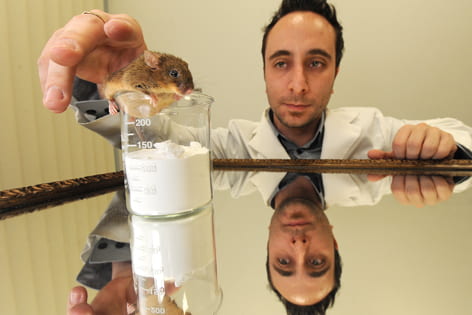Of mice and medicine
Frank LaFerla and his transgenic mouse move UCI to the forefront of Alzheimer’s research

Mice are usually considered lowly creatures – pests, even – but to Frank LaFerla, they represent hope, the hope that one day there will be a cure for Alzheimer’s disease.
LaFerla, professor of neurobiology and behavior and co-director of UCI’s Institute for Brain Aging and Dementia, is at the forefront of Alzheimer’s research. He’s made key breakthroughs in conquering the disease that robs the memory and eventually the life of its victims. LaFerla was the first to engineer mice that develop the plaques and tangles in the brain that characterize Alzheimer’s, providing researchers with a crucial “living laboratory” of the disease. His mice are making a huge impact on his work, as well as Alzheimer’s research around the world.
“Everyone uses the mouse,” says Benjamin Wolozin, professor of pharmacology at Boston University’s Alzheimer’s Disease Center. “His mouse is among the most important tools available to Alzheimer’s researchers.”
According to Abraham Fisher of the Israel Institute for Biological Research, a 25-year veteran of Alzheimer’s research, “No other model mimics Alzheimer’s pathology to such an extent. Such an animal model offers the possibility to answer fundamental questions.”
Much of the progress in recent years made against Alzheimer’s would not have happened had LaFerla followed his original career path.
“I got into the field almost by accident,” LaFerla says. He had trained as a microbiologist, specializing in virology at the University of Minnesota, where he received his doctorate in 1990. During postdoctoral training, he became interested in putting human genes into mice. He transferred to the Red Cross Laboratories in Rockland, Md., one of the few research labs pioneering such work.
“I thought that was the future of modern biology – less toward using cell culture and more toward whole-animal studies; less in vitro and more in vivo,” LaFerla says. “With a whole animal, you can mimic diverse cell-cell interactions.
“The field found me; I didn’t pick it. It was scary, going from microbiology to learning about the brain, and it was challenging. But I couldn’t wait to do it.”
The focus of his research soon changed and as a result, LaFerla says, “I’ve been a hard-core Alzheimer’s researcher for the last 15 years.”
Formidable foe
His professional shift has proven a research boon for the field, where the need for answers is urgent. According to the Alzheimer’s Association, about 4.5 million people across the United States are afflicted with the progressive brain disorder, which gradually destroys a person’s memory and ability to learn, reason, make judgments, communicate and carry out daily activities. With an aging population, that number could approach 20 million by 2050. Alzheimer’s is the third-leading cause of death – behind cancer and heart disease – and the third-most expensive. Five percent of people over 65 have Alzheimer’s; LaFerla estimates one-third to one-half of the population are affected by age 80.
Unlocking Alzheimer’s secrets
Researchers blamed Alzheimer’s on a multitude of causes until about 10 years ago, when they homed in on a common villain: beta-amyloid.
“The last decade has been a bonanza for Alzheimer’s research. Examining genes opened up new venues of research that have been very, very fruitful,” LaFerla says. “We know now that the small protein beta-
amyloid is a major player.”
La Ferla used his mice to show that beta-amyloid may be the initiating component of both kinds of Alzheimer’s – the “sporadic” kind that randomly attacks the elderly and early-onset “familial” Alzheimer’s, which usually attacks people in their 40s and 50s but sometimes strikes those as young as 16 years old.
“Beta-amyloid accumulates regularly in the brain – we don’t know what its right function is,” he says. Healthy brain cells somehow eliminate excess beta-amyloid, but in Alzheimer’s patients the protein builds up inside their brains and forms clumps, or plaques. Plaques cut off communication between cells and are the calling card of Alzheimer’s disease. Conventional wisdom used to hold that plaques grow on the outside of healthy cells, but LaFerla changed that assumption.
“Frank challenged everybody. He was pushing us,” Boston University’s Wolozin says. “He proved that amyloid doesn’t only accumulate outside neurons, but inside neurons. People now accept that as amyloid accumulates inside cells it interferes with cell signaling and leads to clinical symptoms.”
More discoveries followed. In 2004, LaFerla proved the progression of Alzheimer’s can be stopped in mice using specific antibodies to clear up the plaques.
“We demonstrated in the lab that removing plaques from the brain can lead to a total clearance of tangle pathology,” LaFerla says.
The work was seminal – but no cure resulted. The antibody failed in clinical trials because of its side-effects on humans.
“It’s a big step from showing you can make a mouse get better to making a person get better,” Wolozin explains.
Earlier this year, LaFerla and Fisher announced that they had identified a compound, AF267B, that blocks the disease’s progression. It not only relieves the symptoms, but reduces Alzheimer’s plaques and tangles by mimicking the effects of the neurotransmitters that carry messages between brain cells. The compound also increases the levels of an enzyme that suppresses the production of beta-amyloid. AF267B is currently in clinical studies at TorreyPines Therapeutics, a biopharmaceutical company in San Diego. Early results show the compound was well tolerated at tested doses in a group of young, healthy males.
“This may lead to a single class of drugs for treating both the inherited and sporadic forms of the disease,” LaFerla says.
Toward a treatment
In another recent study that may impact treatments for Alzheimer’s, LaFerla found that stress hastens the disease’s progress in mice.
“Although we have known for some time that higher levels of stress hormones are seen in individuals in the early stages of Alzheimer’s, this is the first time we have seen how these hormones play such a direct role in exacerbating the underlying pathology of the disease,” he says.
LaFerla also debunked the common notion that nicotine could be used to treat the disease. In fact, he determined that chronic nicotine exposure worsens Alzheimer’s-related brain abnormalities. This, along with his other discoveries, earned LaFerla the prestigious 2005 MetLife Award for Alzheimer’s Research.
Colleagues praise LaFerla for his brilliance and his energy. They say he’s been amazingly productive, conducting a large number of important experiments, with more on the way.
“He’s one of the true scientists,” Wolozin says. “A lot of researchers go into experiments with an agenda. Frank doesn’t. He is open to the idea that maybe something’s right, maybe it’s not.” The Israel Institute’s Fisher, citing LaFerla’s deep commitment and pioneering work, says he is “convinced his research will influence significantly novel drug designs and therapeutic strategies in Alzheimer’s disease.”
For his part, LaFerla is cautiously optimistic about a cure. “I think our generation will see some effective treatment, but I don’t know if there will be a cure,” he says. “I think it will be like HIV – now physicians say it’s a manageable infection. I don’t think Alzheimer’s will be manageable within five years, but within our generation.”

